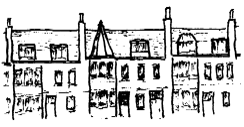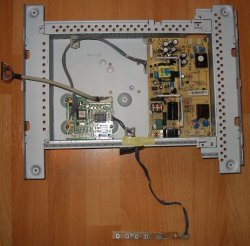
John's computer page
Until recently I had decided not to bore the pants off people by including computer stuff on our pages. However as I have started to move towards free and open source software for our systems I thought it might be useful to others to note my experiences here.
Ubuntu
I moved to ubuntu for my main desktop stuff at the end of 2005, and so far this seems to be able to do most if not all of what I want. It's certainly a lot faster to start up a Linux system on an aging piece of hardware than it is to start up Windoze, which seems to take forever nowadays even on the fastest machine we have (admittedly over 3 years old). No way will I be moving to Vista. However I have also recently (December 2007) been using Fedora 7 (on a laptop - see below) and to date am pretty pleased with it.
Laptops
Laptops used to be a bit of a pain under Linux but things are now much better - however they are still trickier than a desktop. I ran Ubuntu on an old Toshiba Portege 7200, and more recently on a Toshiba R100. This was fine until I upgraded from Dapper to Edgy, when a graphics driver problem began to annoy me. So I hunted around and eventually went back to Fedora, and this seems to be much more solid; I have written up the details for reference, and for anyone else wishing to go this route and looking for answers around graphics and Ogg player issues.
Web page editing
These pages are composed using Nvu which is quite a good open source wysiwyg html editor, though I admit I still do edit html directly with it as well, having started that way! However I use gFTP to publish the files because Nvu likes to store things differently to the way I work.
Nvu does have a css editor as well which is good for things like setting colours; however I also frequently edit the style sheet directly as well whilst developing, then run it through the editor to tidy it up. The current page style is the result of some extensive rethinking, working towards using a content management system like Mambo; but before I go there I want to have my own page design set up properly.
Ubuntu splash screen problem
Since I replaced an old monitor with the current one, I have had problems with the Ubuntu start-up splash screen, with the monitor complaining about out-of-range frequencies. So I finally decided to fix it; there are some helpful suggestions on the fora.
First, it's nothing to do with the X11 settings. It's to do with booting.
There is a configuration file for the grub menu, at /boot/grub/menu.lst
In this file, find the default options line - it's commented but picked up when a new kernel is installed - and add a vga parameter; this one is for 1024x768 at 8 bits. My screen is 1280x1024 but apprently there are limits to what it can do at boot. This makes sure a new kernel will get this setting. My defoptions line is now
# defoptions=quiet splash vga=773
You also need to add the vga option to the default kernel line (at the top after the default options):kernel /boot/vmlinuz-2.6.24-23-generic root=UUID=...a long hex thing... ro quiet splash vga=773
You also need to change /etc/usplash.conf to the same settings (backup the old just in case!); mine now has
xres=1024
yres=768
You then need to run
dpkg-reconfigure usplash
and try rebooting - you should then see the Ubuntu splash screen with the orange progress bar.
Setting up wireless on Ubuntu
Recently I upgraded a laptop from Dapper Drake to Edgy Eft - not a good idea, the graphics driver was broken and moving windows around on the screen made a real mess. However I thought I'd give Feisty Fawn a go and that is not bad (only real problem is that Picasa, which I rather liked, doesn't work very well - but I installed digiKam and that actually looks better in many ways. Back to the story though ...
As it's a laptop, wireless is Really Useful. However, out of the box the network configuration for wireless in Ubuntu is less than clever. It took a bit of Googling to find
http://www.debianadmin.com/enable-wpa-wireless-access-point-in-ubuntu-linux.html
recommended by Ageros on the usalug forum. Many thanks Ageros! This gets NetworkManager working properly - it comes installed but not properly enabled.
Flat screen monitor problem - LG Flatron L1717S
I recently had a problem with the flat screen monitor on my office computer - an intermittent of course - though it gradually got worse. The symptom was that the image would disappear and the green light in the bottom right (near the on-off button) would flash. By waggling the mains connector the image could be made to reappear - at first realiably, later not very reliably.
I realised that this was a loose connection probably in the mains circuit when I heard buzzing on the audio system when I waggled the mains input lead! So since it was well out of guarantee I decided to open the box.
That was not too difficult, though not obvious. There are just two screws on the back at the centre of the bottom of the screen unit, behind the stand. With these out, the front fascia can be eased off - there are two or three plastic lugs on the black back of the unit, and the fascia is clipped over these. Only one broke off in this process but you need to be careful!
 |
 |
With the fascia off, it's realatively easy to get the works out of the black plastic back; the control panel needs to have a small lug bent sideways then it slides off a couple of plastic hooks. There are then four screws on the edges of the unit (near A in the left hand picture above) which allow separation of the display panel from the electronics chassis (right hand picture). Before separating the electronics chassis, unplug the connectors, two on each side, under the metal screens marked B in the left hand picture; the metal screens slide off easily. The display panel can also be unplugged from the driver card - see loose connecting wire on the left of the right hand picture.
The PSU is the right hand board, and I simply resoldered connections near the IEC mains socket that looked likely to be loose, and also (probably more important) soldered the connecting pillars to the back of the socket's connectors - these were just riveted and I suspect one was probably loose.
Since this work, no problems - the monitor is back to its original working state. It's a great monitor so I'm glad to have managed to fix the intermittent fault.